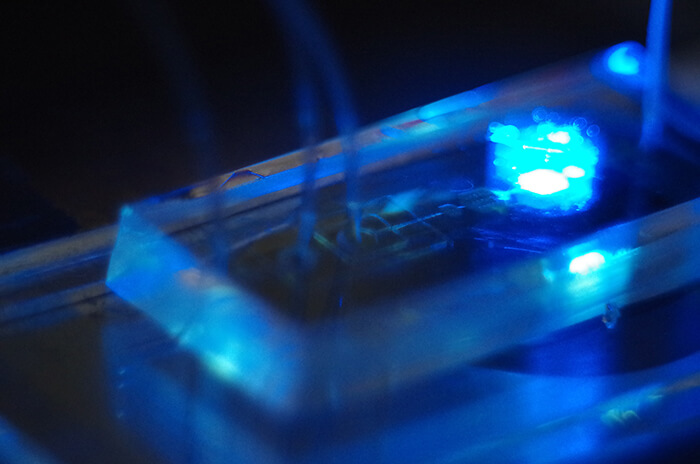Applications
Droplet microfluidic is a technology that finds great benefits in a lot of applications like medicine, pharmaceutics, cosmetics and in the agro-industry. The miniaturization achieved with microfluidic system allows to decrease the quantity of reagents, the time of the analyze, the cost whereas it increases the accuracy of the analysis.
One of the crucial parameters of droplet based microfluidic experiments is the droplet stability. Depending on the application, the droplets have to be stable on a whole range of parameters like temperature, pH and time. At Emulseo, we provide a high quality of surfactants, oils and surface treatments for reproducible, reliable and robust droplet based microfluidic experiments.

Digital Droplet PCR
Digital Polymerase Chain Reaction (PCR) is a highly precise technique used to make multiple copies of small target DNA fragments to a large enough amount to facilitate their detection and quantification.
With digital droplet PCR, samples are partitioned into thousands of individual reactions of defined volume inside water-in-oil microdroplets. PCR amplification of the template nucleic acids occurs in each droplet with high sensitivity. Droplets are individually analyzed and scored as positive (fluorescent droplet containing target sequence) or negative (non-fluorescent). Poisson statistics are then applied to the fraction of positive droplets to calculate the absolute concentration of the template nucleic acids.
Some of the advantages of this technology in comparison with standard quantitative PCR include the possible detection of rare events, copy number variation, and absolute quantification with high precision and sensitivity.
Our surfactants allow to keep droplets stable throughout the whole PCR workflow while preserving the integrity of their content.
Screening
Single-cell analysis
Droplet based microfluidic applied to the study of single cells has enabled a huge advance in the extraction of information at the genomic transcriptomic, proteomic and metabolic level. This breakthrough leads to a better understanding of the genetic and functional heterogeneity of cell division, growth, metabolism, and apoptosis.
Droplet based microfluidic allows the isolation of cells in monodispersed droplet population with a controlled environment. With droplet based microfluidic, cells are compartmentalized into picoliter or nanoliter droplets. The droplets are then analyzed and/or sorted leading to quantitative measurements with a very high precision.
Droplet based microfluidic applied to single cells analysis allows to perform high-throughput and low-cost analysis of single cells.
Our FluoSurf™ surfactant allows to keep the droplets stable throughout the whole process guaranteeing a high reproducibility. FluoSurf™ is biocompatible and produced in large quantities. All those advantages make FluoSurf™ a surfactant especially suitable for single-cell analysis.
Synthetic biology
Synthetic biology is an emerging field of science that aims to engineer artificial biological systems in a real-time deep monitoring. The controlled environment is attractive for different applications and the mimic in vivo systems reveal advantages that can improve the molecular understanding of processes, relevant for life science discoveries.
The technology can be employed in medical, chemical and biomaterial fields, providing a revolutionary tool in the understanding of basic life sciences operating in every level, from proteins to organs. Synthetic Biology advance us for building multicellular systems functional tissue formation in vitro and the possibility of transformative advances in regenerative medicine.
The use of microfluidic technology in synthetic biology led to a reduction of time and costs, showing at the same time, an accurate control over the biological content within microscale devices and performance in the analysis of biological and biochemical samples compared with the conventional macroscale instruments.
Control of chemical and biological reactions
The application of microscale systems has been stimulated by the fact that physical processes can be more easily controlled and harnessed when instrumental dimensions are reduced to the micrometer size.
In the chemical and biological sciences many studies have been developed by the need to perform the comprehension of reactions. These systems can help to predict how molecular synthesis might be revolutionized in chemical and in high-throughput synthesis production.
Microfluidic technology has become a powerful tool for complex chemical and biological experiments once the droplets provide an ideal confined environment for fundamental studies on reactions. The compartmentalization consists of a cell or a molecule isolation inside a droplet and has as a goal to mimic some of the essential features of the chemical environment in living cells.
The knowledge of how enzymatic reactions work will permit us to better understand biological systems and lead us to the discover new chemical reactions.

